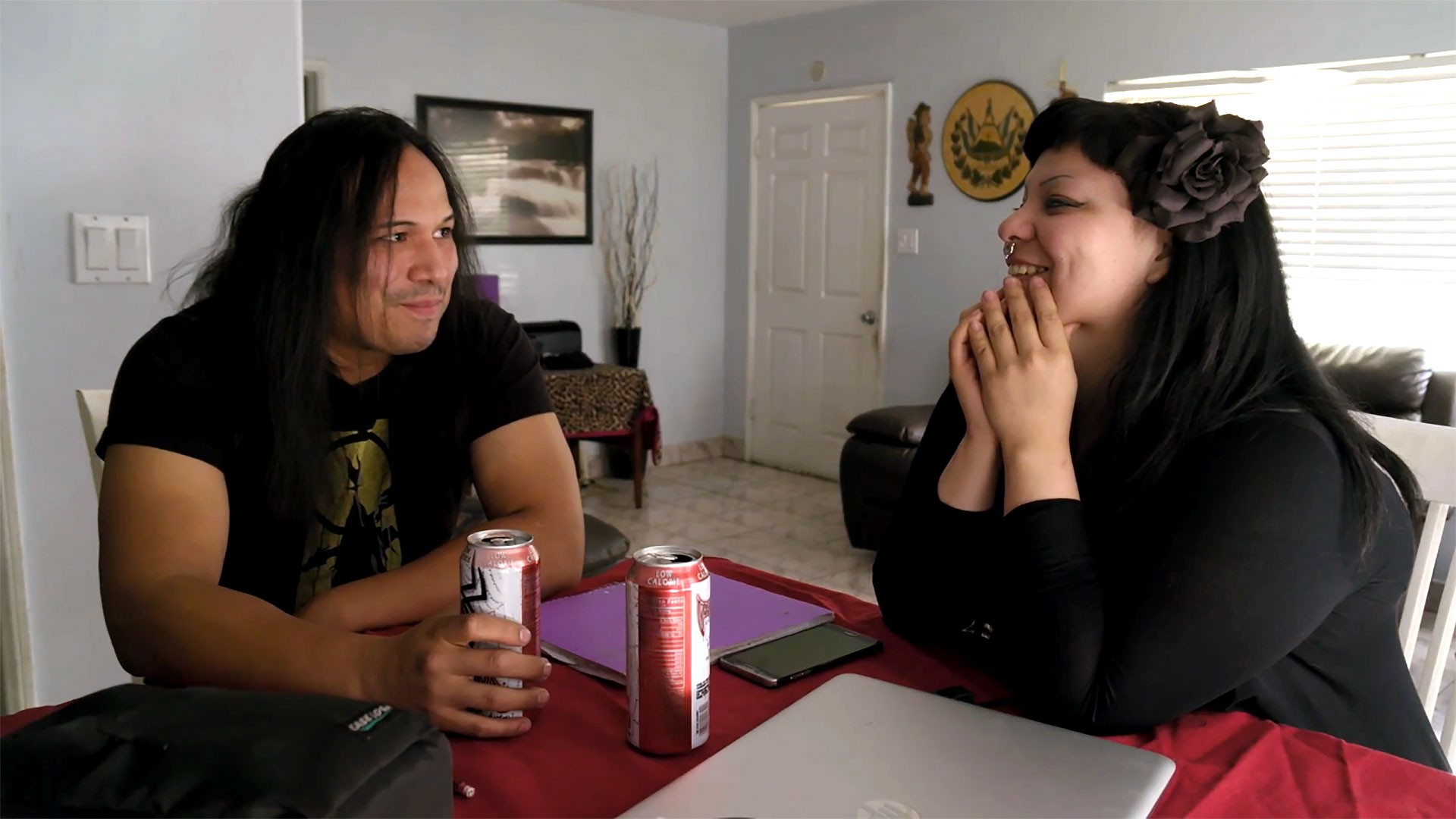Photo credit: HBO
Goth Latinx kids finally have a show for them, thanks to Los Espookys. The Spanish-language HBO series, which premiered Friday, follows a band of horror-loving weirdos living somewhere in Mexico (it seems, based on the accents and other signifiers) who create a business out of building creepy sets for clients trying to scare the ever-loving crap out of people for a variety of reasons. It's a show for anyone who's ever watched an episode of Primer Impacto with their rosary-wielding nana yelling about endemoniados, duendes, or brujas voladoras. It's also for the Latinxs who've described themselves as "bien darks" (i.e. goth) and struggle to find representation that isn't pandering.Created by Fred Armisen, comedian Julio Torres, and actress Ana Fabrega, who also star alongside Bernardo Velasco and Cassandra Ciangherotti, the series does what few Latinx-centered comedies, particularly in America, can do: being in the culture while avoiding the caricatures and tropes that reinforce stereotypes of the culture.When Latinx-centered comedies are given air time, they often lean heavily on the slapstick comedy popular in Latinx culture, as well as stereotypes of Latinx people. There are plenty of examples through entertainment history in Latin America, from the problematic India Maria, an indigenous female character ridiculed for her extreme stupidity, to Eugenio Derbez, the Mexican actor whose ridiculous catchphrases (Fue horrible! Fue horrible!) and exaggerated expressions made him a favorite among older generations, and who has been making a crossover to the American market in movies like the Overboard reboot. In Mexico and other Latin American countries, kids grew up watching grown-ass adults dressed as freckly children in the vein of La Chilindrina (a character who is 8 years old but played by María Antonieta de las Nieves, who is 68) or beloved host Chabelo, an 84-year-old man meant to be some sort of very wrinkly child—complete with an affected screechy kid voice and a pair of overalls. These comedic archetypes are such a part of the canon of Latinx entertainment that they're made fun of in American comedy, like Arrested Development and its Premios Desi, which also made sure to add a joke about Lucille Bluth thinking all the Latinx men there were waiters.

Latinx folk are often painted the same way in comedy: big, loud, sexy or virginal (can't be both, sorry), and often lacking dimension. Subtlety and nuance is often missing. Jane the Virgin and Ugly Betty built themselves on being Americanized telenovelas (Ugly Betty was itself based on the telenovela Yo Soy Betty, La Fea), with plenty of the Latin Lover archetype, people dramatically being pushed down stairs, and the-dead-not-actually-being-dead action that has kept Televisa and Univision rolling in soap opera ratings. One Day at a Time, Netflix's now-canceled comedy centered on a Cuban-American family, was a welcome departure for pushing more inclusive storytelling and revolving around a Cuban family (Mexican families tend to be most often depicted in shows about Latinx people), but its multi-cam sitcom style and after-school-special-style messaging felt dated at times. There are series currently attempting to change that representation—or at least broaden it to include a more nuanced depiction of Latinx people—like Starz's Vida or Netflix's On My Block, but those aren't comedies. Latinx-centered comedy still struggles with finding the sweet spot between making the joke that's for us and making the joke that makes fun of us.That's what makes Los Espookys so special. Not only because it is mostly in Spanish and airing on HBO (exciting by itself), but because of the comedy it delivers. It's completely weird (Fabrega's ditzy Tati is called into a priest’s office to spin a fan so the priest can cool down, but is fired on the spot for not spinning fast enough), perfectly dumb (Armisen's enthusiastic Tico is a parking attendant who signals he's leaving a room by saying "Bip! Bip!" like a car horn), and often bone-dry (Torres' blue-haired, queer Andrés, heir to a chocolate empire called Charlie Wonka's, threatens a dentist that he'll create a sugar-free chocolate and thus put him out of business), but the references to the culture aren't shoehorned in. The big, loud, sassy histrionics are gone, but the identifiers of its cultural heritage are still there in ways that are obvious to a Latinx audience without beating them over the head. Even so, it's broad enough so that everyone can laugh at the completely bonkers world of horrors the creators have built, and enjoy its sweet, childish core.The characters themselves are an evolution of how Latinx people are seen in TV comedies. Torres serves dark, bitchy energy, providing a hilarious representation of queer identity that doesn't lean on offensive, soft-wrist caricature. He's a razor-sharp queen, and his riches serve to empower his fearlessness in demanding what he wants, speaking to the classism that permeates Latinx culture. He is beyond wealthy, dripping in fashion, but his love of spooks and scares must come second to his calling as an heir to a chocolate fortune, creating what he dramatically refers to as "choco-drama." Velasco's character, Renaldo, is a pure vampiro rockero, looking like a hardcore Caifanes fan with his long hair, black trench, and metal jewelry. He is also poor, referring at various points to the lack of minutes on his cell phone—if you get it, you get it. Are they the deepest, most complex characters? No, but they are a welcome breath of fresh air in a landscape that's only given us a handful of options as to who we are.In the pilot episode, a priest needing to assert his dominance over a hot, glossy-lipped new priest calls on the group to create a fake demonic possession, positioning him to perform an exorcism before TV cameras to gain fame. The fictional tabloid series, Mira Esto, is modeled after the hilariously unhinged tabloid shows that pepper TV screens mid-day in Latinx households across the world, with an attractive host warning the audience of paranormal entities threatening the fabric of their pure Catholic world. It's a callback to the superstition and scare tactics that keep Latinx kids everywhere in fear of the actual devil taking over their body, La Llorona claiming their soul, or chupacabras ripping their eyes out. Tati ends up playing the possessed girl, projectile vomiting on the cute, glossed-up priest and screeching in pretend pain, then, when given the cue, stands up and declares she's fine, walking out of the room as though nothing had happened. Los Espookys quietly cheer from behind the wall where they've orchestrated the entire fallacy, bought without hesitation by the nuns and TV producers on the other side. If my mom were to have seen that episode of Mira Esto, she would've bought it too. It's hard to explain why, but the superstitious and religious nature of Latinx culture means we are simultaneously frightened and fascinated by the paranormal, real or not. This is a culture where a news program will air a segment on a garden gnome being captured on tape after somehow coming to life, and the hosts assure its veracity. A group of haunt-loving dweebs could definitely make a decent living producing horrors.Los Espookys finds that sweet spot of making laughs for us by us, particularly for those of us who don't fit the tropes that media has created of our identity. It shares lineage with What We Do in the Shadows and Flight of the Conchords' dry, oddball wit, and adds the dash of telenovela that gives it its dippy drama, giving Latinx viewers who struggle to see themselves in the shows about them a reflection of their weirdo, bien darks selves. After all, goths have long lived darkly and deliciously in Latin America, incurring the fascination, amusement, concern, and sometimes fear of many. There's room for the slapsticky stuff, sure. We need more voices and experiences of color in television. Los Espookys helps carve room for the others—the freaks and the geeks who delight in the absurdity of a gnome caught on tape and partake in a midnight listen of The Cure and Santa Sabina.Sign up for our newsletter to get the best of VICE delivered to your inbox daily.Follow Alex Zaragoza, who is only somewhat darks, on Twitter.
Advertisement
Advertisement

Latinx folk are often painted the same way in comedy: big, loud, sexy or virginal (can't be both, sorry), and often lacking dimension. Subtlety and nuance is often missing. Jane the Virgin and Ugly Betty built themselves on being Americanized telenovelas (Ugly Betty was itself based on the telenovela Yo Soy Betty, La Fea), with plenty of the Latin Lover archetype, people dramatically being pushed down stairs, and the-dead-not-actually-being-dead action that has kept Televisa and Univision rolling in soap opera ratings. One Day at a Time, Netflix's now-canceled comedy centered on a Cuban-American family, was a welcome departure for pushing more inclusive storytelling and revolving around a Cuban family (Mexican families tend to be most often depicted in shows about Latinx people), but its multi-cam sitcom style and after-school-special-style messaging felt dated at times. There are series currently attempting to change that representation—or at least broaden it to include a more nuanced depiction of Latinx people—like Starz's Vida or Netflix's On My Block, but those aren't comedies. Latinx-centered comedy still struggles with finding the sweet spot between making the joke that's for us and making the joke that makes fun of us.That's what makes Los Espookys so special. Not only because it is mostly in Spanish and airing on HBO (exciting by itself), but because of the comedy it delivers. It's completely weird (Fabrega's ditzy Tati is called into a priest’s office to spin a fan so the priest can cool down, but is fired on the spot for not spinning fast enough), perfectly dumb (Armisen's enthusiastic Tico is a parking attendant who signals he's leaving a room by saying "Bip! Bip!" like a car horn), and often bone-dry (Torres' blue-haired, queer Andrés, heir to a chocolate empire called Charlie Wonka's, threatens a dentist that he'll create a sugar-free chocolate and thus put him out of business), but the references to the culture aren't shoehorned in. The big, loud, sassy histrionics are gone, but the identifiers of its cultural heritage are still there in ways that are obvious to a Latinx audience without beating them over the head. Even so, it's broad enough so that everyone can laugh at the completely bonkers world of horrors the creators have built, and enjoy its sweet, childish core.
Advertisement
